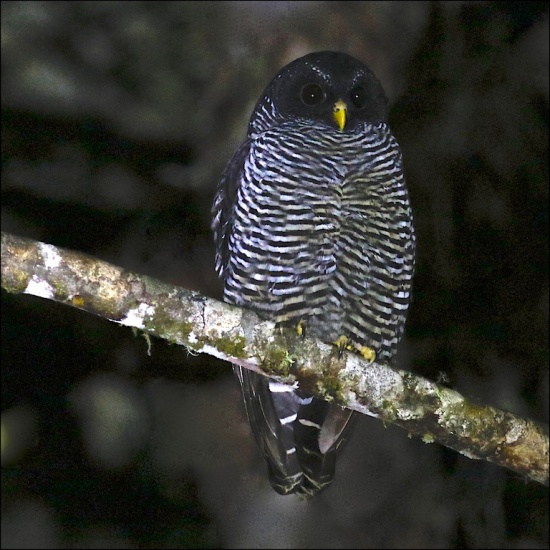
Cabanas San Isidro near Cosanga, Napo Province, San Isidro Reserve, Ecuador, January 2016
- Strix nigrolineata
Ciccaba nigrolineata
Identification
33-45cm (13-17¾ in); females larger
White and black stripes on neck, stomach, and chest, white stripes on mostly black back and tail with a prominent, mostly white collar around the rear neck, black face with white speckled brows over dark-brown eyes.
The feet and bill are an orange-yellow.
Distribution
Lowlands of southern Mexico to western Ecuador and extreme northwestern Peru
Taxonomy
This is a monotypic species[1] which, in the past, was considered conspecific with Black-banded Owl.
Ciccaba vs. Strix
Most authorities (Sibley & Monroe, 1996) retain Mottled Owl (virgata), Black-and-white Owl (nigrolineata), Black-banded Owl (huhula), and Rufous-banded Owl (albitarsis) in the genus Strix. König et al. state that the general morphology and phylogenetic evidence of these four species does not indicate separation from the rest of Strix, and Restall goes on to explain that they were originally separated into the genus Ciccaba based on anatomy of the external ear. As Clements (2022) and IOC (2022) also place these species in Strix, the Opus follows.
Habitat
Lowlands to mid elevation, mostly wet forests including mangrove but also borders and urban parks. Observed at heights up to ca. 2,000 m (6,560 ft) elevation.
Behaviour
Nocturnal; spends the day high in dense vegetation.
Breeding
They nest mostly in natural holes in stumps and trees, but may also use old nests of squirrels, hawks or crows or place eggs within epiphytes. The 1 or 2 eggs are white.
Diet
The diet includes primarily insects and small mammals including bats. Several locations have lamps that attract insect and are regularly visited by this species of owl, known examples range from Costa Rica to Ecuador (at least).
References
- Clements, J. F., T. S. Schulenberg, M. J. Iliff, T. A. Fredericks, J. A. Gerbracht, D. Lepage, S. M. Billerman, B. L. Sullivan, and C. L. Wood. 2022. The eBird/Clements checklist of Birds of the World: v2022. Downloaded from https://www.birds.cornell.edu/clementschecklist/download/
- BF Member observations
- König, C. and F. Weick 2008. Owls of the World, second edition. Christopher Helm, London. ISBN 978-0-7136-6548-2
- Restall et al. 2006. Birds of Northern South America. Yale University Press. ISBN 9780300124156
- BF Member observations
Recommended Citation
- BirdForum Opus contributors. (2025) Black-and-white Owl. In: BirdForum, the forum for wild birds and birding. Retrieved 13 May 2025 from https://www.birdforum.net/opus/Black-and-white_Owl
External Links
GSearch checked for 2020 platform.1



